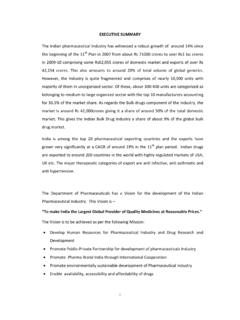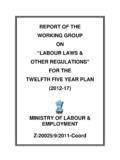Transcription of Overview of the framework - Planning Commission
1 I Overview of the framework Large investments, public as well as the private, will be needed in various infrastructure sectors to meet the growing needs of the Indian economy. The public sector would continue to play an important role in building infrastructure and would need to ensure efficient and timely construction of projects within the agreed costs. Towards this end, it would be necessary to adopt a modern contractual framework in the form of a standardised Engineering, Procurement and Construction (EPC) contract based on international best practices. Need for EPC contracts The various departments and undertakings of the Central Government as well as the State Governments have hitherto been undertaking construction projects through the conventional item rate contracts where the Government provides the detailed design as well as the estimates of quantities for different items of work (Bill of Quantities).
2 Payments to the Contractor are made on the basis of measurements of the work done in respect of each item. Experience shows that item rate contracts are prone to excessive time and cost overruns, besides recurrent disputes involving large claims. The reasons for their poor performance include inadequate project preparation and estimation coupled with allocation of several construction risks to the Government. For these reasons, the item rate mode of contracting has long been discarded in the developed countries as well by the private sector in India. The structure currently in vogue is in the nature of turnkey contracts where the responsibility for design, procurement and construction is assigned to the Contractor.
3 Such contracts are typically known as EPC contracts. Model EPC Agreement The aforesaid drawbacks of item rate contracting are addressed by the EPC approach that relies on assigning the responsibility for investigations, design and construction to the Contractor for a lump sum price determined through competitive bidding. The objective is to ensure implementation of the project to specified standards with a fair degree of certainty relating to costs and time while transferring the construction risks to a private sector Contractor. With a view to enabling a transparent, fair and competitive roll out of projects, a model EPC Agreement has been evolved.
4 This Model EPC Agreement incorporates international best practices and provides a sound contractual framework that specifies the allocation of risks and rewards, equity of obligations between the Authority and the Contractor, precision and predictability of costs, force majeure, termination and dispute resolution, apart from transparent and fair procedures. A modern EPC framework is a pre-requisite for efficient delivery Item rate contracts are outdated The Model EPC Agreement incorporates best practices ii The Model EPC Agreement specifies the required design and performance standards and allows the Contractor to design and construct the project using best practices and innovation to optimise on efficiency and economy as compared to the rigidity of the item rate contract that relies on a rigid design provided by the project authorities.
5 The Contractor also has full freedom to plan the construction schedule for efficient use of its manpower, equipment and other resources while payments are linked to specified stages of construction as compared to payment for individual items or units specified in the item rate contracts. Awarding contract for a lump sum price ensures predictability and financial discipline, both for the Contractor and the Authority. Moreover, clearly stated obligations and risks of the respective parties help in achieving timely completion of the project while minimising disputes. Technical parameters Unlike the normal practice of focussing on construction specifications, the technical parameters proposed in the Agreement are based mainly on output specifications.
6 Only the core requirements of design, construction and operation that have a bearing on the quality and safety of the project are to be specified and enough room is left for the Contractor to innovate and add value. In sum, the framework focuses on the what rather than the how in relation to the works to be delivered by the Contractor. This would provide the requisite flexibility to the Contractor in evolving and adopting innovative designs without compromising on quality of the works. Contract Price The Contract Price is a fixed lump sum amount for construction of the project. The Contract Price is subject to adjustment on account of changes in the relevant price index as well as changes in law or changes in the scope of the project since the Contractor cannot be expected to bear or manage the risks arising out of such changes.
7 Contract period The contract period is normally determined on a project-specific basis depending on the nature and volume of construction work involved. The Contractor shall be liable to damages for any delay beyond the specified date of completion, subject to the damages not exceeding 10 per cent of the contract price. However, the Contractor shall be entitled to time extension arising out of delays on account of change of scope and force majeure or delays caused by or attributable to the Authority. Selection of Contractor Selection of the Contractor will be based on open competitive bidding.
8 All project parameters such as the contract period, price adjustments and technical parameters are to be clearly stated upfront, and short-listed bidders will be required to specify Technical parameters based on output specifications Time extension only for specified event or circumstance Competitive bidding on single parameter will be the norm Contract price to be lump sum iii only the lump sum price for the project. The bidder who seeks the lowest payment should win the contract. Risk allocation As an underlying principle, risks have been allocated to the parties that are best suited to manage them.
9 Project risks have, therefore, been assigned to the private sector to the extent it is capable of managing them. The transfer of such risks and responsibilities to the private sector would increase the scope of innovation leading to efficiencies in costs and services. Accordingly, project risks such as commercial and technical risks relating to design and construction have been assigned to the Contractor. The Authority would, however, be liable to damages for any delays in handing over land, securing environment clearances or shifting of utilities. Design and Construction The EPC agreement specifies the dates on which different sections of the project land will be handed over to the Contractor.
10 It defines the scope of the project with precision and predictability to enable the Contractor to determine its costs and obligations. It also lays down a ceiling of 10 percent of contract price to cater for any changes in the scope of the project, the cost of which the Authority shall bear. The Contractor shall carry out survey and investigations and also develop designs and drawings in conformity with the specifications and standards laid down in the Agreement. It will get these checked by a proof consultant and a safety consultant who are to be appointed with the approval of the Authority.









